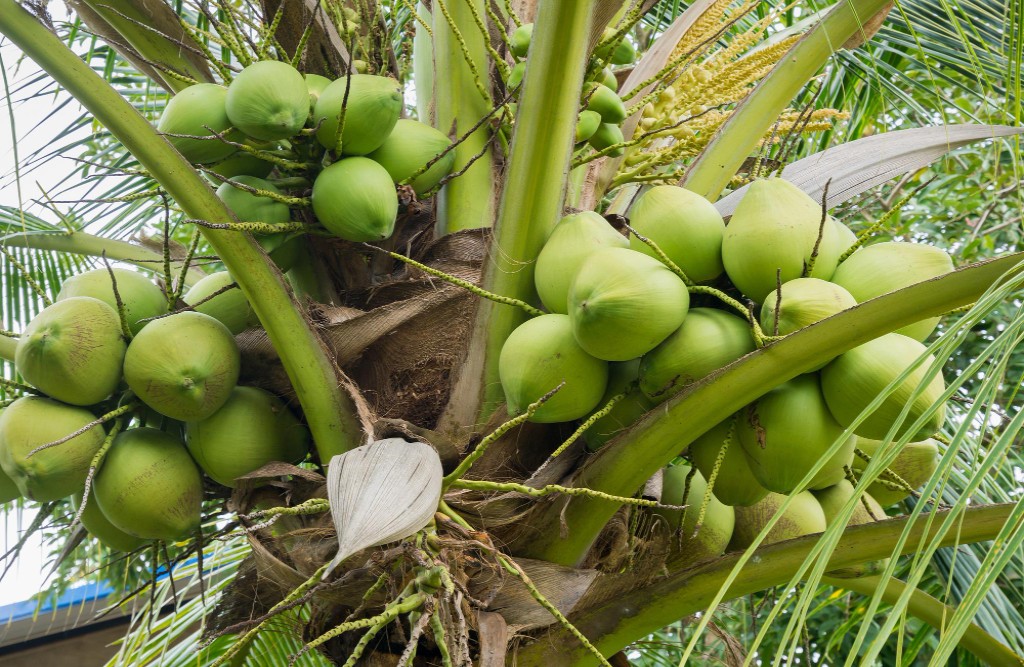
Techniques for Coconut Production Coconut serves as the primary source of livelihood for many farming families. Kerala holds the top position in India in terms of coconut production and cultivated area. However, farmers often only partially adopt scientific crop methods. It is crucial for farmers to employ techniques that enhance income from coconut cultivation, leverage technological advancements to achieve higher production capacity, and minimize agricultural expenses. Coconut cultivation is prominent in the states of Tamil Nadu, Andhra Pradesh, and Karnataka.
Coconut cultivation thrives in diverse climatic and soil conditions, typically found at lower altitudes and prevalent in tropical regions. Coconut gardens can flourish at elevations of up to 1000 meters in nearby areas. Achieving high yields from coconut palms, with up to 200 nuts per square meter annually, is feasible. Adequate irrigation is crucial, especially in regions with low rainfall.
Consistent fertilization is paramount from the initial planting year to promote fruiting and maximize yields. Ideally, planting should commence in May-June coinciding with the onset of the monsoon, followed by the first fertilizer application in August-September, three months later. For coconut palms, annually administer 500 grams of nitrogen, 320 grams of phosphorus, and 1200 grams of potassium. Utilize 1 kg of urea, 1.5 kg of muriate of potash or rock phosphate, or 2 kg of murate of potash per palm for this purpose. Fertilizer application should be immediate upon planting. During August-September, construct basins around the coconut tree, 1.8 meters in diameter and 25 cm deep, and incorporate 25 kg of green leaves or compost per palm. To prevent coconut leaf yellowing, apply half a kilogram of magnesium sulfate per palm in September-October. Use organic fertilizers such as cow dung compost, green leaves, vermicompost, etc.
Implementing Irrigation Techniques for Coconut Cultivation
From December to May, irrigation is essential for coconut palms in the western coastal regions. In areas where basin irrigation is practiced, 200 liters per palm should be provided at intervals of 4 days. In areas facing water scarcity, drip irrigation can be utilized. Approximately 30-32 liters of water per palm are required in this manner. In mixed cropping, furrow irrigation can be employed for irrigation, which yields more benefits compared to other methods. It results in a water saving of about 36 percent compared to basin irrigation.
To cultivate coconuts, start by preparing mounds in well-drained locations. If planting in open areas, provide shade during hot days. The mounds should be constructed at a height and width of one and a half meters, with a distance of 75 cm between each mound. In areas with poor water drainage, plant seedlings directly on the mounds. During the early monsoon months of May-June, sow the seedlings onto the mounds. Maintain a spacing of 30 cm between each seedling and between rows. Dig holes in the mound, 25-30 cm deep, and plant the seedlings. After planting, only expose the upper part of the seedling above the soil, covering the rest with soil. Maintain a distance of 7.5 meters between coconut plants, adjusted according to the size of the coconut tree. Typically, around 175 trees can be planted per hectare. Alternatively, using a triangular planting pattern, 20 to 25 palms can be planted. Another method of planting coconuts is by using the hedge method.
For planting coconut seedlings, it is advisable to choose a one-year-old plant from the nursery. The seedling should have a minimum of 6 leaves and be at least 10 cm tall. Good seedlings show early sprouting. Avoid selecting seedlings that have not sprouted within six months and show slow growth.
Uses of Coconut: Coconut is beneficial for promoting health. It is used to make salted chips by dipping them in saltwater, as well as sweetened chips by mixing them with sugar and salt. It is also used in the production of biscuits, sweets, confectionery, and various culinary items. High-quality activated charcoal is obtained from fully mature and dried coconut shells. In India, there is a significant market potential for coconut oil produced from coconut milk. Coconut is also used in the preparation of Ayurvedic medicines, infant massage oils, etc. There is a high demand for natural vinegar, which is made from coconut sap, in the export market. Traditional machetes are used in India to harvest coconuts.
Plant Protection: The main pests are aphids, rhinoceros beetles, leaf-eating caterpillars, Ramie moth, Aphis nerii, Aerenoscella, red palm weevil, Rynchophorus ferrugineus, and white grub. Prevention - Neem oil mixed with azadirachtin should be used against aphids. Spraying a mixture of 20 liters of neem oil, 20 grams of garlic, and 5 grams of soap in one liter of water is also effective for controlling aphids.
Read More... Carrot Cultivation will be a Profitable Crop for Farmers and will Provide Good Production